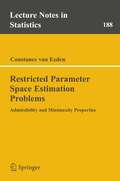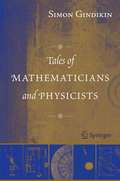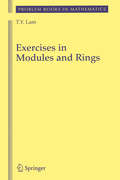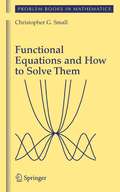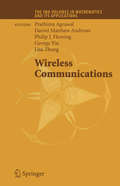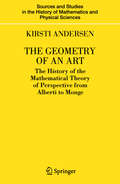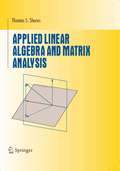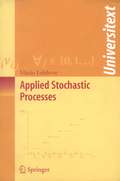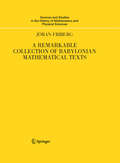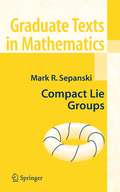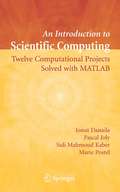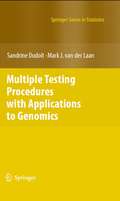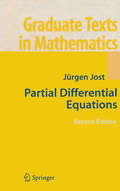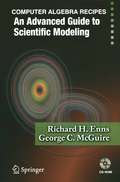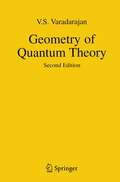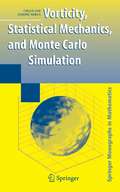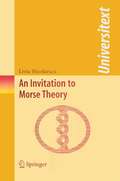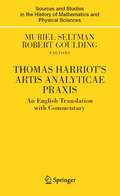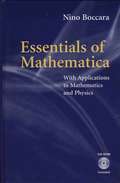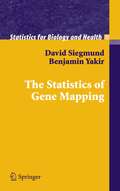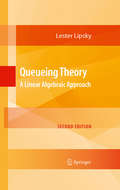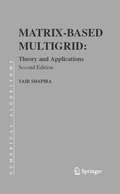- Table View
- List View
Restricted Parameter Space Estimation Problems: Admissibility and Minimaxity Properties (Lecture Notes in Statistics #188)
by Constance van EedenThis monograph is addressed to anyone interested in the subject of restrict- parameter-space estimation, and in particular to those who want to learn, or bring their knowledge up to date, about (in)admissibility and minimaxity problems for such parameter spaces. The coverage starts in the early 1950s when the subject of inference for - stricted parameter spaces began to be studied and ends around the middle of 2004. It presents known, and also some new, results on (in)admissibility and minimaxity for nonsequential point estimation problems in restricted ?ni- dimensional parameter spaces. Relationships between various results are d- cussed and open problems are pointed out. Few complete proofs are given, but outlines of proofs are often supplied. The reader is always referred to the published papers and often results are clari?ed by presenting examples of the kind of problems an author solves, or of problems that cannot be solved by a particular result. The monograph does not touch on the subject of testing hypotheses in - stricted parameter spaces. The latest books on that subject are by Robertson, Wright and Dykstra (1988) and Akkerboom (1990), but many new results in that area have been obtained since. The monograph does have a chapter in which questions about the existence of maximum likelihood estimators are discussed. Some of their properties are also given there as well as some algorithms for computing them. Most of these results cannot be found in the Robertson, Wright, Dykstra book.
Tales of Mathematicians and Physicists
by Simon GindikinThis revised and greatly expanded second edition of the Russian text contains a wealth of new information about the lives and accomplishments of more than a dozen scientists throughout five centuries of history: from the first steps in algebra up to new achievements in geometry in connection with physics. The heroes of the book are renowned figures from early eras, as well some scientists of last century. A unique mixture of mathematics, physics, and history, this volume provides biographical glimpses of scientists and their contributions in the context of the social and political background of their times.
Exercises in Modules and Rings (Problem Books in Mathematics)
by T.Y. LamThis volume offers a compendium of exercises of varying degree of difficulty in the theory of modules and rings. It is the companion volume to GTM 189. All exercises are solved in full detail. Each section begins with an introduction giving the general background and the theoretical basis for the problems that follow.
Functional Equations and How to Solve Them (Problem Books in Mathematics)
by Christopher G. SmallMany books have been written on the theory of functional equations, but very few help readers solve functional equations in mathematics competitions and mathematical problem solving. This book fills that gap. Each chapter includes a list of problems associated with the covered material. These vary in difficulty, with the easiest being accessible to any high school student who has read the chapter carefully. The most difficult will challenge students studying for the International Mathematical Olympiad or the Putnam Competition. An appendix provides a springboard for further investigation of the concepts of limits, infinite series and continuity.
Averaging Methods in Nonlinear Dynamical Systems (Applied Mathematical Sciences #59)
by Jan A. Sanders Ferdinand Verhulst James MurdockPerturbation theory and in particular normal form theory has shown strong growth in recent decades. This book is a drastic revision of the first edition of the averaging book. The updated chapters represent new insights in averaging, in particular its relation with dynamical systems and the theory of normal forms. Also new are survey appendices on invariant manifolds. One of the most striking features of the book is the collection of examples, which range from the very simple to some that are elaborate, realistic, and of considerable practical importance. Most of them are presented in careful detail and are illustrated with illuminating diagrams.
Wireless Communications (The IMA Volumes in Mathematics and its Applications #143)
by Prathima Agrawal Matthew D. Andrews Philip J. Fleming G. George Yin Lisa ZhangThis volume contains papers based on invited talks given at the 2005 IMA Summer Workshop on Wireless Communications, held at the Institute for Mathematics and Its Applications, University of Minnesota, June 22 - July 1, 2005. It presents some of the highlights of the workshop, and collects papers covering a broad spectrum of important and pressing issues in wireless communications.
The Geometry of an Art: The History of the Mathematical Theory of Perspective from Alberti to Monge (Sources and Studies in the History of Mathematics and Physical Sciences)
by Kirsti AndersenThis review of literature on perspective constructions from the Renaissance through the 18th century covers 175 authors, emphasizing Peiro della Francesca, Guidobaldo del Monte, Simon Stevin, Brook Taylor, and Johann Heinrich. It treats such topics as the various methods of constructing perspective, the development of theories underlying the constructions, and the communication between mathematicians and artisans in these developments.
Applied Linear Algebra and Matrix Analysis (Undergraduate Texts in Mathematics)
by Thomas S. ShoresThis new book offers a fresh approach to matrix and linear algebra by providing a balanced blend of applications, theory, and computation, while highlighting their interdependence. Intended for a one-semester course, Applied Linear Algebra and Matrix Analysis places special emphasis on linear algebra as an experimental science, with numerous examples, computer exercises, and projects. While the flavor is heavily computational and experimental, the text is independent of specific hardware or software platforms. Throughout the book, significant motivating examples are woven into the text, and each section ends with a set of exercises.
Applied Stochastic Processes (Universitext)
by Mario LefebvreThis book uses a distinctly applied framework to present the most important topics in stochastic processes, including Gaussian and Markovian processes, Markov Chains, Poisson processes, Brownian motion and queueing theory. The book also examines in detail special diffusion processes, with implications for finance, various generalizations of Poisson processes, and renewal processes. It contains numerous examples and approximately 350 advanced problems that reinforce both concepts and applications. Entertaining mini-biographies of mathematicians give an enriching historical context. The book includes statistical tables and solutions to the even-numbered problems at the end.
A Remarkable Collection of Babylonian Mathematical Texts: Manuscripts in the Schøyen Collection: Cuneiform Texts I (Sources and Studies in the History of Mathematics and Physical Sciences)
by Jöran FribergThe book analyzes the mathematical tablets from the private collection of Martin Schoyen. It includes analyses of tablets which have never been studied before. This provides new insight into Babylonian understanding of sophisticated mathematical objects. The book is carefully written and organized. The tablets are classified according to mathematical content and purpose, while drawings and pictures are provided for the most interesting tablets.
Compact Lie Groups (Graduate Texts in Mathematics #235)
by Mark R. SepanskiBlending algebra, analysis, and topology, the study of compact Lie groups is one of the most beautiful areas of mathematics and a key stepping stone to the theory of general Lie groups. Assuming no prior knowledge of Lie groups, this book covers the structure and representation theory of compact Lie groups. Coverage includes the construction of the Spin groups, Schur Orthogonality, the Peter-Weyl Theorem, the Plancherel Theorem, the Maximal Torus Theorem, the Commutator Theorem, the Weyl Integration and Character Formulas, the Highest Weight Classification, and the Borel-Weil Theorem. The book develops the necessary Lie algebra theory with a streamlined approach focusing on linear Lie groups.
An Introduction to Scientific Computing: Twelve Computational Projects Solved with MATLAB
by Ionut Danaila Pascal Joly Sidi Mahmoud Kaber Marie PostelThis book demonstrates scientific computing by presenting twelve computational projects in several disciplines including Fluid Mechanics, Thermal Science, Computer Aided Design, Signal Processing and more. Each follows typical steps of scientific computing, from physical and mathematical description, to numerical formulation and programming and critical discussion of results. The text teaches practical methods not usually available in basic textbooks: numerical checking of accuracy, choice of boundary conditions, effective solving of linear systems, comparison to exact solutions and more. The final section of each project contains the solutions to proposed exercises and guides the reader in using the MATLAB scripts available online.
Multiple Testing Procedures with Applications to Genomics (Springer Series in Statistics)
by Sandrine Dudoit Mark J. van der LaanThis book establishes the theoretical foundations of a general methodology for multiple hypothesis testing and discusses its software implementation in R and SAS. These are applied to a range of problems in biomedical and genomic research, including identification of differentially expressed and co-expressed genes in high-throughput gene expression experiments; tests of association between gene expression measures and biological annotation metadata; sequence analysis; and genetic mapping of complex traits using single nucleotide polymorphisms. The procedures are based on a test statistics joint null distribution and provide Type I error control in testing problems involving general data generating distributions, null hypotheses, and test statistics.
Partial Differential Equations (Graduate Texts in Mathematics #214)
by Jürgen JostThis book offers an ideal introduction to the theory of partial differential equations. It focuses on elliptic equations and systematically develops the relevant existence schemes, always with a view towards nonlinear problems. It also develops the main methods for obtaining estimates for solutions of elliptic equations: Sobolev space theory, weak and strong solutions, Schauder estimates, and Moser iteration. It also explores connections between elliptic, parabolic, and hyperbolic equations as well as the connection with Brownian motion and semigroups. This second edition features a new chapter on reaction-diffusion equations and systems.
Computer Algebra Recipes: An Advanced Guide to Scientific Modeling
by Richard H. Enns George C. McGuireThis book presents a large number of computer algebra worksheets or "recipes" that have been designed using MAPLE to provide tools for problem solving and to stimulate critical thinking. No prior knowledge of MAPLE is necessary. All relevant commands are introduced on a need-to-know basis and are indexed for easy reference. Each recipe features a scientific model or method and an interesting or amusing story designed to both entertain and enhance concept comprehension and retention.
Geometry of Quantum Theory: Second Edition
by V.S. VaradarajanAvailable for the first time in soft cover, this book is a classic on the foundations of quantum theory. It examines the subject from a point of view that goes back to Heisenberg and Dirac and whose definitive mathematical formulation is due to von Neumann. This view leads most naturally to the fundamental questions that are at the basis of all attempts to understand the world of atomic and subatomic particles.
Vorticity, Statistical Mechanics, and Monte Carlo Simulation (Springer Monographs in Mathematics)
by Chjan Lim Joseph NebusThis book is drawn from across many active fields of mathematics and physics. It has connections to atmospheric dynamics, spherical codes, graph theory, constrained optimization problems, Markov Chains, and Monte Carlo methods. It addresses how to access interesting, original, and publishable research in statistical modeling of large-scale flows and several related fields. The authors explicitly reach around the major branches of mathematics and physics, showing how the use of a few straightforward approaches can create a cornucopia of intriguing questions and the tools to answer them.
An Invitation to Morse Theory (Universitext)
by Liviu NicolaescuThis book offers readers a taste of the "unreasonable effectiveness" of Morse theory. It covers many of the most important topics in Morse theory along with applications. The book details topics such as Morse-Smale flows, min-max theory, moment maps and equivariant cohomology, and complex Morse theory. In addition, many examples, problems, and illustrations further enhance the value of this useful introduction to Morse Theory.
Thomas Harriot's Artis Analyticae Praxis: An English Translation with Commentary (Sources and Studies in the History of Mathematics and Physical Sciences)
by Muriel Seltman Robert GouldingThis is the first English translation of Thomas Harriot’s seminal Artis Analyticae Praxis, first published in Latin in 1631. It has recently become clear that Harriot's editor substantially rearranged the work, and omitted sections beyond his comprehension. Commentary included with this translation relates to corresponding pages in the manuscript papers, enabling exploration of Harriot's novel and advanced mathematics. This publication provides the basis for a reassessment of the development of algebra.
Essentials of Mathematica: With Applications to Mathematics and Physics
by Nino BoccaraThis book teaches how to use Mathematica to solve a wide variety of problems in mathematics and physics. It is based on the lecture notes of a course taught at the University of Illinois at Chicago to advanced undergrad and graduate students. The book is illustrated with many detailed examples that require the student to construct meticulous, step-by-step, easy to read Mathematica programs. The first part, in which the reader learns how to use a variety of Mathematica commands, contains examples, not long explanations; the second part contains attractive applications.
The Statistics of Gene Mapping (Statistics for Biology and Health)
by David Siegmund Benjamin YakirThis book details the statistical concepts used in gene mapping, first in the experimental context of crosses of inbred lines and then in outbred populations, primarily humans. It presents elementary principles of probability and statistics, which are implemented by computational tools based on the R programming language to simulate genetic experiments and evaluate statistical analyses. Each chapter contains exercises, both theoretical and computational, some routine and others that are more challenging. The R programming language is developed in the text.
Queueing Theory: A Linear Algebraic Approach
by Lester LipskyQueueing Theory deals with systems where there is contention for resources, but the demands are only known probabilistically. This book can be considered to be a monograph or a textbook, and thus is aimed at two audiences: those who already know Queueing Theory but would like to know more of the Linear Algebraic Approach; and as a rst course for students who don't already have a strong background in probability, and feel more comfortable with algebraic arguments. Also, the equations are well suited to easy computation. In fact, there is much discussion on how various properties can be easily computed in any language that has automatic matrix operations (e.g., MATLAB). To help with physical insight, there are over 80 gures, numerous examples and exercises distributed throughout the book. There are, perhaps 50 books on QT that are available today, and most practitioners have several of them on their shelves. This book would be a good addition, as well as a good supplement to another text. This second edition has been updated throughout including a new chapter on Semi Markov Processes and new material on matrix representations of distributions and Power-tailed distribution. Lester Lipsky is a Professor in the Department of Computer Science and Engineering at the University of Connecticut.
Bounded Analytic Functions (Graduate Texts in Mathematics #236)
by John GarnettThis book is an account of the theory of Hardy spaces in one dimension, with emphasis on some of the exciting developments of the past two decades or so. The last seven of the ten chapters are devoted in the main to these recent developments. The motif of the theory of Hardy spaces is the interplay between real, complex, and abstract analysis. While paying proper attention to each of the three aspects, the author has underscored the effectiveness of the methods coming from real analysis, many of them developed as part of a program to extend the theory to Euclidean spaces, where the complex methods are not available.
Matrix-Based Multigrid: Theory and Applications (Numerical Methods and Algorithms #2)
by Yair ShapiraMatrix-Based Multigrid introduces and analyzes the multigrid approach for the numerical solution of large sparse linear systems arising from the discretization of elliptic partial differential equations. Special attention is given to the powerful matrix-based-multigrid approach, which is particularly useful for problems with variable coefficients and nonsymmetric and indefinite problems. This book can be used as a textbook in courses in numerical analysis, numerical linear algebra, and numerical PDEs at the advanced undergraduate and graduate levels in computer science, math, and applied math departments. The theory is written in simple algebraic terms and therefore requires preliminary knowledge only in basic linear algebra and calculus.
Linking and Aligning Scores and Scales (Statistics for Social and Behavioral Sciences)
by Mary Pommerich Paul W. Holland Neil J. DoransIn this book, experts in statistics and psychometrics describe classes of linkages, the history of score linkings, data collection designs, and methods used to achieve sound score linkages. They describe and critically discuss applications to a variety of domains. They define what linking is, to distinguish among the varieties of linking and to describe different procedure for linking. Furthermore, they convey the complexity and diversity of linking by covering different areas of linking and providing diverse perspectives.
